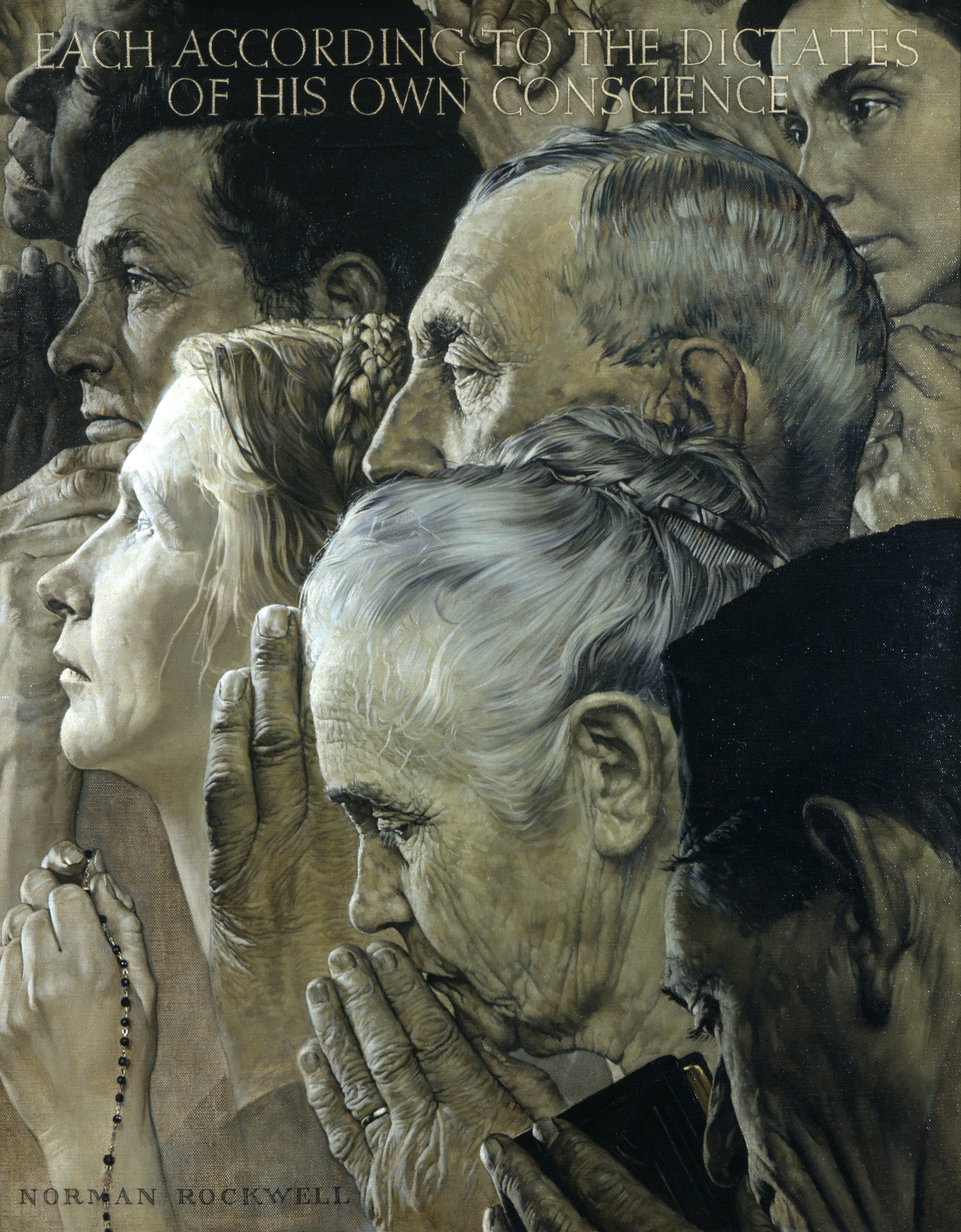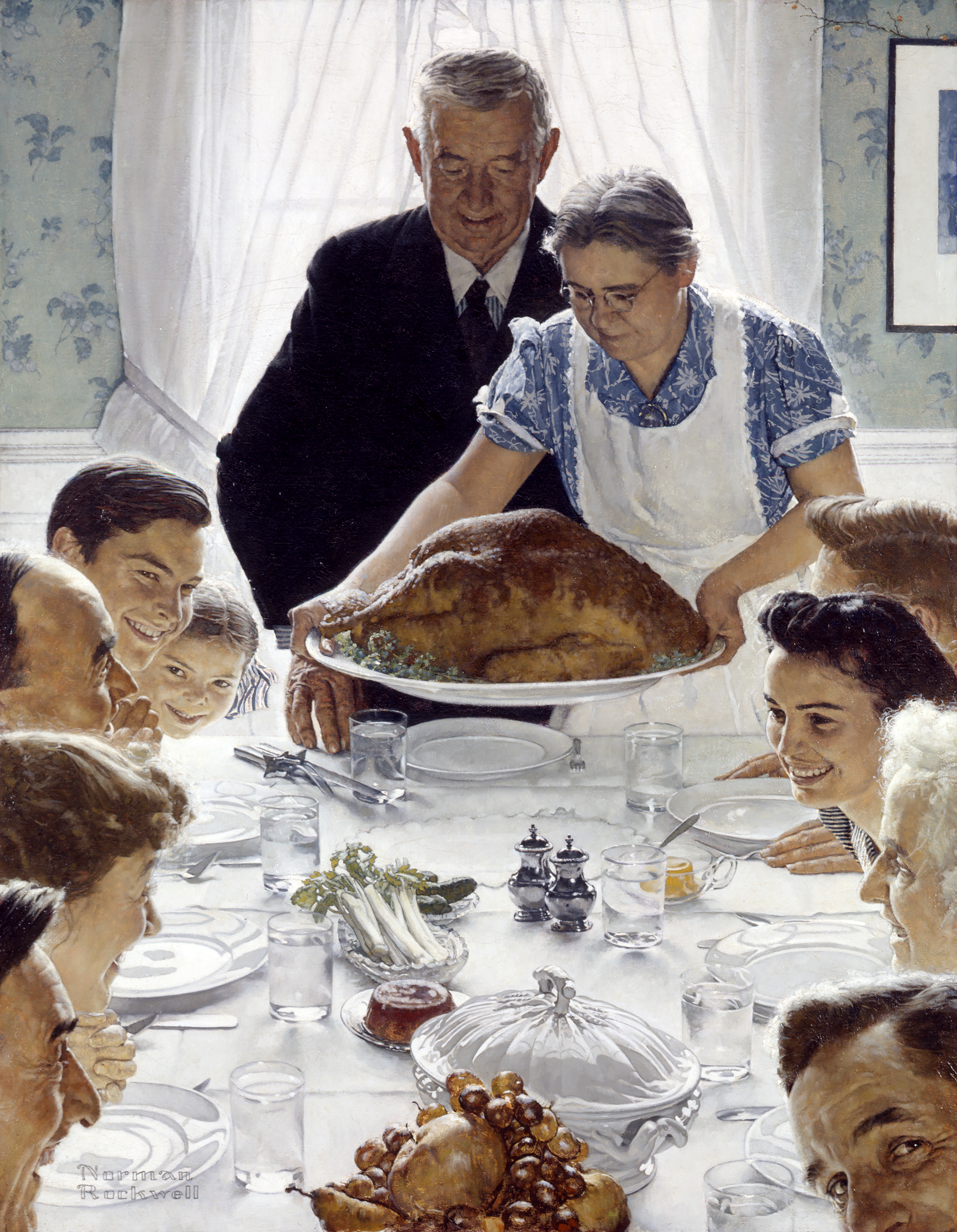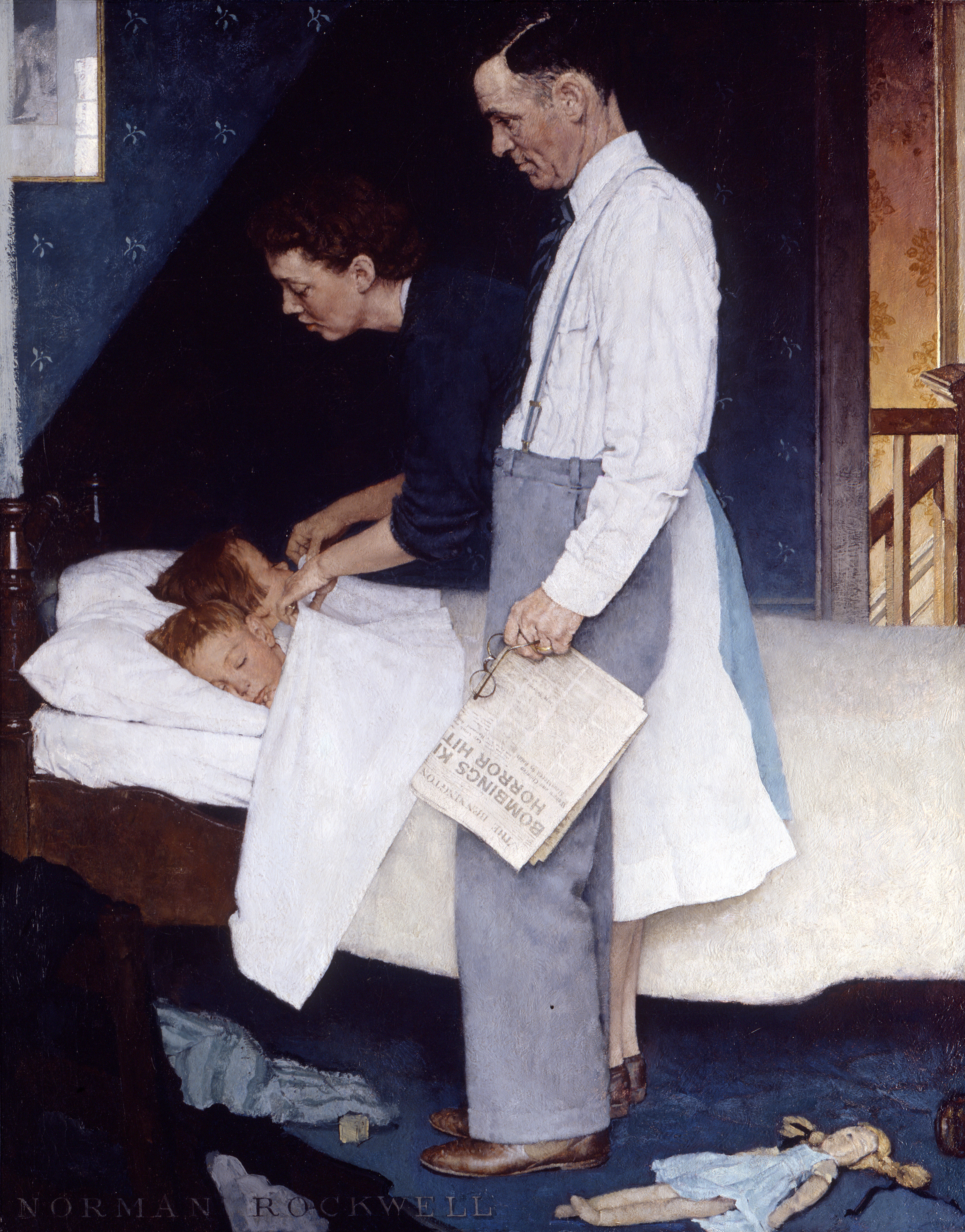Close Reading of the Four Freedoms
Overview:
Students learn about the history and meaning of the Four Freedoms which President Roosevelt identified in his 1941 State of the Union Address to Congress. Through close reading and discussion about Norman Rockwell's illustrations, students identify the narrative behind the Four Freedom. They identify and discuss details in the illustrations to make and support inferences reflecting the meaning of the four freedoms in our everyday lives.
Expect the lesson for each Four Freedoms illustration will take about 45 minutes to make a four day series.
Enduring Understandings/ Essential Questions:
- The Four Freedoms are for all citizens of the world.
- President Roosevelt named the Four Freedoms as Freedom from Want, Freedom from Fear, Freedom of Worship, And Freedom of Speech.
- The Four Freedoms are reflected in our lives.
- Are the four freedoms named by President Roosevelt relevant today?
- How are the Four Freedoms reflected in your life?
- Do all citizens of the world enjoy these freedoms in the same way?
- What does “freedom” mean to you? What Four Freedoms would you identify today as most important to you and your community?
- Grade
- 6-8
- Theme
- Four Freedoms
- Length
- 4 periods, 45 minutes each
- Discipline
- Social Studies; Language Arts: Reading; Language Arts: Speaking and Listening
- Vocabulary
- Freedom; Worship; Want; Need; Speech; Citizens
Objectives:
- Students will closely examine each of the Four Freedom illustrations painted by Norman Rockwell.
- Students will make inferences related to the details and the freedom title.
- Students will reflect on the how the four freedoms relate to them.
- Students will participate in discussions focusing on the four freedoms.
- In addition, students will analyze and discuss the relationship between the illustration and the text of the related essay.
Background:
World War II began in 1939. The United States was not involved in the beginning of the war, however, President Franklin Roosevelt believed that the United States would eventually need to play a larger role. In January 1941, he made his speech to Congress. In his speech, President Roosevelt named the Four Freedoms, which he stated are the rights of everyone in the world. After the speech, in an effort to convey the underlying message of the Four Freedoms, the President reached out to the art world for help. Many artists created works to reflect the meaning of these freedoms in the form of paintings, sculptures, prints, musical compositions, and more. Norman Rockwell thought a lot about these ideals. In February and March of 1943, his completed Four Freedoms illustrations were published in The Saturday Evening Post, each along with a related essay. Exceedingly popular at the time and distributed widely as prints and posters, Norman Rockwell's illustrations raised over 132 million dollars toward the war effort through the purchase of war bonds. Prints of Rockwell’s Four Freedoms were given as premiums when people purchased war bonds in varying denominations. His illustrations became the face of the Four Freedoms and they continue to represent the meaning of these freedoms today.
Materials:
Multimedia Resources
Freedom of Speech
Freedom of Worship
Freedom from Want
Freedom from Fear
Norman Rockwell's Four Freedoms
Norman Rockwell Museum
Franklin D. Roosevelt's Four Freedoms
Norman Rockwell Museum
Classroom Supplies:
- Chart paper with T-chart labeled "What I see (notice)/ What I think (can infer)
- Marker
Activities:
Present each illustration separately. It works well to focus on one freedom per day. Allow 30 to 40 minutes for the reading and discussion of each illustration. The illustration of Freedom from Want is particularly accessible to students and a good starting place for most classes.
- Initiating Activity: Share excerpt from President Roosevelt’s Freedom Speech.
- Display the illustration of Freedom from Want.
- Ask students to look carefully at the illustration. Give them a few minutes to do this in silence.
- Turn and Talk: When you feel enough time has passed, have students turn to a person sitting beside them. Ask them to share with each other some of the things they notice in the illustration. As they are sharing, circulate and listen to what students are saying.
- Have partners share a detail they noticed in the picture and an inference they have about its significance. Record their responses on the T-Chart. (Elicit observations you heard during partner talk which will further the class conversation.)
- Turn and Talk: When everyone has had an opportunity to share, have students turn to face their partners again. Were they surprised by any comments? Do they agree or disagree with classmates inferences about the significance of different details?
- Share the origin of the painting and its name. Give as much information as is appropriate for the maturity of the students. At some point, you may want to discuss the use of the word “want” in the title as many students may associate it with things they wish to have rather than “want of necessities” such as food, shelter, family and friends, water, etc. Share with them that there are four paintings in this collection. They will have opportunity to look at the others over the next week (or whatever schedule you determine).
- Each of the illustrations was paired with a related essay. If appropriate for the class, read aloud the related essay after close reading of the illustration. You may want to give students a copy of essays to read along. Discuss the relationship between each illustrations and its related essay.
Assessment:
Assessment:
- Did everyone participate?
- Were students able to give details from the picture to support their thinking?
- Are students able to identify the importance of the contributions made by President Roosevelt and Norman Rockwell?
- Can students relate the significance of the four freedoms in their lives? Do they believe the Four Freedoms are relevant today? What if any additional freedoms would they advocate for?
Standards
This curriculum meets the standards listed below. Look for more details on these standards please visit: ELA and Math Standards, Social Studies Standards, Visual Arts Standards.
- CCSS.ELA-Literacy.RL.6.4
- Determine the meaning of words and phrases as they are used in a text, including figurative and connotative meanings; analyze the impact of a specific word choice on meaning and tone
- CCSS.ELA-Literacy.RL.6.5
- Analyze how a particular sentence, chapter, scene, or stanza fits into the overall structure of a text and contributes to the development of the theme, setting, or plot.
- CCSS.ELA-Literacy.RL.6.6
- Explain how an author develops the point of view of the narrator or speaker in a text.
- CCSS.ELA-Literacy.RL.7.4
- Determine the meaning of words and phrases as they are used in a text, including figurative and connotative meanings; analyze the impact of rhymes and other repetitions of sounds (e.g., alliteration) on a specific verse or stanza of a poem or section of a story or drama.
- CCSS.ELA-Literacy.RL.7.5
- Analyze how a drama's or poem's form or structure (e.g., soliloquy, sonnet) contributes to its meaning
- CCSS.ELA-Literacy.RL.7.6
- Analyze how an author develops and contrasts the points of view of different characters or narrators in a text.
- CCSS.ELA-Literacy.RL.8.4
- Determine the meaning of words and phrases as they are used in a text, including figurative and connotative meanings; analyze the impact of specific word choices on meaning and tone, including analogies or allusions to other texts.
- CCSS.ELA-Literacy.RL.8.5
- Compare and contrast the structure of two or more texts and analyze how the differing structure of each text contributes to its meaning and style.
- CCSS.ELA-Literacy.RL.8.6
- Analyze how differences in the points of view of the characters and the audience or reader (e.g., created through the use of dramatic irony) create such effects as suspense or humor.
- CCSS.ELA-Literacy.SL.6.1
- Engage effectively in a range of collaborative discussions (one-on-one, in groups, and teacher-led) with diverse partners on grade 6 topics, texts, and issues, building on others' ideas and expressing their own clearly.
- CCSS.ELA-Literacy.SL.6.2
- Interpret information presented in diverse media and formats (e.g., visually, quantitatively, orally) and explain how it contributes to a topic, text, or issue under study.
- CCSS.ELA-Literacy.SL.6.3
- Delineate a speaker's argument and specific claims, distinguishing claims that are supported by reasons and evidence from claims that are not.
- CCSS.ELA-Literacy.SL.7.1
- Engage effectively in a range of collaborative discussions (one-on-one, in groups, and teacher-led) with diverse partners on grade 7 topics, texts, and issues, building on others' ideas and expressing their own clearly.
- CCSS.ELA-Literacy.SL.7.2
- Analyze the main ideas and supporting details presented in diverse media and formats (e.g., visually, quantitatively, orally) and explain how the ideas clarify a topic, text, or issue under study.
- CCSS.ELA-Literacy.SL.7.3
- Delineate a speaker's argument and specific claims, evaluating the soundness of the reasoning and the relevance and sufficiency of the evidence.
- CCSS.ELA-Literacy.SL.8.1
- Engage effectively in a range of collaborative discussions (one-on-one, in groups, and teacher-led) with diverse partners on grade 8 topics, texts, and issues, building on others' ideas and expressing their own clearly.
- CCSS.ELA-Literacy.SL.8.2
- Analyze the purpose of information presented in diverse media and formats (e.g., visually, quantitatively, orally) and evaluate the motives (e.g., social, commercial, political) behind its presentation.
- CCSS.ELA-Literacy.SL.8.3
- Delineate a speaker's argument and specific claims, evaluating the soundness of the reasoning and relevance and sufficiency of the evidence and identifying when irrelevant evidence is introduced.
- CCSS.ELA-Literacy.CCRA.SL.6
- Adapt speech to a variety of contexts and communicative tasks, demonstrating command of formal English when indicated or appropriate.
- CCSS.ELA-Literacy.RI.6.1
- Cite textual evidence to support analysis of what the text says explicitly as well as inferences drawn from the text.
- CCSS.ELA-Literacy.RI.6.2
- Determine a central idea of a text and how it is conveyed through particular details; provide a summary of the text distinct from personal opinions or judgments.
- CCSS.ELA-Literacy.RI.6.7
- Integrate information presented in different media or formats (e.g., visually, quantitatively) as well as in words to develop a coherent understanding of a topic or issue.
- CCSS.ELA-Literacy.RI.7.1
- Cite several pieces of textual evidence to support analysis of what the text says explicitly as well as inferences drawn from the text.
- CCSS.ELA-Literacy.RI.7.2
- Determine two or more central ideas in a text and analyze their development over the course of the text; provide an objective summary of the text.
- CCSS.ELA-Literacy.RI.7.7
- Compare and contrast a text to an audio, video, or multimedia version of the text, analyzing each medium's portrayal of the subject (e.g., how the delivery of a speech affects the impact of the words).
- CCSS.ELA-Literacy.RI.8.1
- Cite the textual evidence that most strongly supports an analysis of what the text says explicitly as well as inferences drawn from the text.
- CCSS.ELA-Literacy.RI.8.2
- Determine a central idea of a text and analyze its development over the course of the text, including its relationship to supporting ideas; provide an objective summary of the text.
- CCSS.ELA-Literacy.RI.8.7
- Evaluate the advantages and disadvantages of using different mediums (e.g., print or digital text, video, multimedia) to present a particular topic or idea.
- D1.1.6-8.
- Explain how a question represents key ideas in the field.
- D1.4.6-8.
- Explain how the relationship between supporting questions and compelling questions is mutually reinforcing.
- D2.Civ.1.6-8.
- Distinguish the powers and responsibilities of citizens, political parties, interest groups and the media in a variety of governmental and nongovernmental contexts.
- D2.Eco.2.6-8.
- Evaluate alternative approaches or solutions to current economic issues in terms of benefits and costs for different groups and society as a whole.
- D2.Geo.4.6-8.
- Explain how cultural patterns and economic decisions influence environments and the daily lives of people in both nearby and distant places.
- D2.His.2.6-8.
- Classify series of historical events and developments as examples of change and/or continuity.
- D2.His.3.6-8.
- Use questions generated about individuals and groups to analyze why they, and the developments they shaped, are seen as historically significant.
- D3.4.6-8.
- Develop claims and counterclaims while pointing out the strengths and limitations of both.
- D4.1.6-8.
- Construct an argument using claims and evidence from multiple sources, while acknowledging the strengths and limitations of the argument.



